With better comfort and freight capacity plus lower cost, it is the Regional Profit Machine.

Airbus A300-600R wide-bodied medium range transport (JT9D engines)
The "range curves" with baggage allowance and full fuel reserves allowance is made for airways routings instead of the most direct routings and for headwinds for that particular region; it is because these winds differ from route to route that the "curves" are not in fact perfect circles.
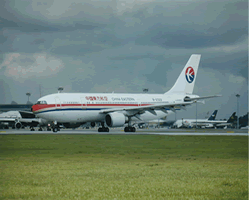 |
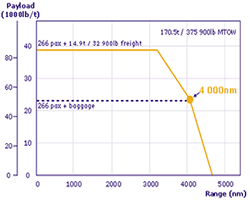  |
 |
Below are two non-specific cabin arrangements showing A300 single-class and two-class layouts.
 |
 |
|
Single Class Layout
|
Two Class Layout
|
Seating plan for a Cabin layout comparison with the rest of the family.
|
Class
|
Seats
|
Pitch
|
| Single |
298
|
298Y at 32/33in h
|
| Two |
266
|
26F at 40in + 240Y at 32in h
|
|
Aircraft Dimensions
|
||
|
ft
|
m
|
|
|
Overall Length |
177ft 5in
|
54.10m
|
| Cabin Length |
133ft 6in
|
40.70m
|
| Fuselage Diameter |
18ft 6in
|
5.64m
|
| Max. Cabin Width |
17ft 4in
|
5.28m
|
| Height |
54ft 3in
|
16.54m
|
| Wheelbase |
61ft
1in
|
18.62m
|
| Track |
31ft 6in
|
9.60m
|
|
Wing Dimensions
|
||
|
ft
|
m
|
|
| Wing Span (geometric) |
147ft 1in
|
44.84m
|
| Wing Area (reference) |
2 800ft
|
2 260m2
|
| Sweep (25% chord) |
28 degrees
|
|
|
Design Weights
|
||
|
lb x 1 000
|
tonnes
|
|
| Max. Ramp Weight |
365.8 (380.5)
|
165.9 (172.6)
|
| Max. Take-off Weight |
363.8 (378.5)
|
165.0 (171.7)
|
|
Max. Landing Weight |
304.2
(308.6)
|
138.0 (140)
|
| Max. Zero Fuel Weight |
286.6
|
130.0
|
|
Max. Fuel Capacity |
USg 16
380 litres 62 000
|
|
| Typical Operating Weight Empty |
198.6
|
90.1
|
| Typical Volumetric Payload |
76.9
|
34.9
|
|
Basic Operating Data |
||
| Powerplants |
two CF6-80C2 or PW 4000
|
|
| Thrust Range |
lb slst 56 000-61 500
|
|
|
Typical Seating (two class) |
266 |
|
| Range (max. pax) |
nm 4 050 (4 150)
MMkm 7 500 (7 700) |
|
| Max. Operating Mach No. |
(Mmo)M0.82
|
|
|
Containers Underfloor
|
||
| Standard/Option Hold Volume - |
22/23 Pallets Underfloor 4Bulk
|
|
| Standard/Option |
610ft3
17.3m3 |
318ft3
9.0m3 |
| Total Volume - Standard/Option 4 |
086ft3
115.7m3 |
3
952ft3
111.9m3 |
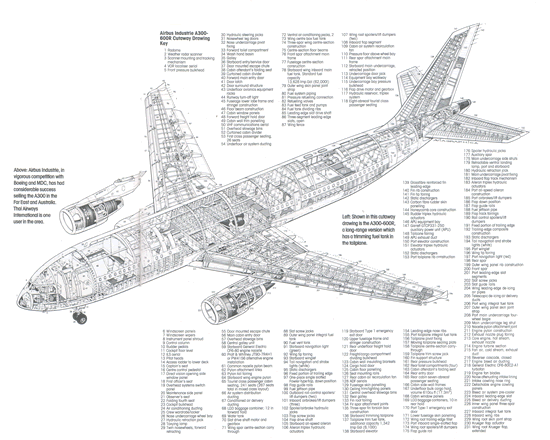
The A300-600 has the true widebody fuselage best suited to the comfort and space efficiency needed to adapt to different markets that increase revenue.
The A300-600's biggest advantage lies in its profitability in the upper end of the mid-size class. With up to 28 more seats than its nearest competitor and offering more practical use of the underfloor hold volume, the A300-600 has substantially greater revenue-generating potential. With the same passenger load factor, one A300-600 makes US$1.4 million more profit per year than the alternative.
|
Direct operating
cost per seat on 2000 nm sector
|
|
|
A300-F has been designed
for optimum operating efficiency in regional operations, and in medium-range
routes with range capability up to 4000 nm (7700km). This careful optimization
has made A300-F the most popular aircraft for freight operation.
The "range curves" with a full fuel reserves allowance are made for airways routings instead of most direct routings and for headwinds for that particular region; it is because these winds differ from route to route that "curves" are not in fact perfect circles.
 |
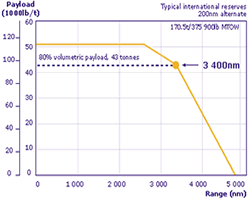 |
 |
Below are two non-specific main deck arrangements showing A300-F different layouts.
 |
 |
222-inch fuselage cross-section of A300-F offers genuine, usable cargo volume on main deck as well as in generous, well-matched underfloor holds. Capable of carrying all common Unit Load Devices as belly-cargo, Airbus Freighters provide unique marketing and revenue generating advantages over their semi-widebody and narrowbody-section competitors
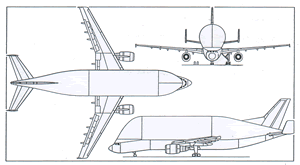
SATIC Airbus A300-600ST Super Transporter being built to transport Airbus airframe sections
Numbers in parentheses are highest options.
|
Aircraft Dimensions
|
||
|
ft
|
m
|
|
| Overall Length |
177ft 5in
|
54.10m
|
| Cabin Length |
133ft 6in
|
40.70m
|
| Fuselage Diameter |
18ft 6in
|
5.64m
|
| Max. Cabin Width |
17ft 4in
|
5.28m
|
| Height |
54ft 3in
|
16.54m
|
| Wheelbase |
61ft 1in
|
18.62m
|
| Track |
31ft 6in
|
9.60m
|
|
Wing Dimensions
|
||
|
ft
|
m
|
|
| Wing Span (geometric) |
147ft 1in
|
44.84m
|
| Wing Area (reference) |
2
800ft2
|
260m2
|
| Sweep (25% chord) |
28 degrees
|
|
|
Design Weight |
||
|
lb x 1 000
|
tonnes
|
|
| Max. Ramp Weight |
377.9/366.0
|
171.4/168.8
|
| Max. Take-off Weight |
375.9/370.4
|
170.5/168.0
|
| Max. Landing Weight |
308.6/315.5
|
140.0/143.3
|
| Max. Zero Fuel Weight |
286.6/300.9
|
130.0/136.5
|
| Max. Fuel Capacity |
USg 18 000/11 730
litres 68 150/44 400 |
|
|
Typical Operating Weight Empty |
174.2
|
79.0
|
|
Typical Volumetric Payload |
120.8/112.4
|
54.8/51.0
|
|
Basic operating data Powerplants |
two CF6-80C2
or PW 4000 |
|
|
Thrust Range |
lb slst 52 000 - 61 500
|
|
|
Main deck freight |
15 (21) pallets
|
|
|
Range (80% volumetric) |
nm 1 950/2 650
km 3 650/4 850 |
|
|
Max. Operating Mach No. (Mmo) |
M0.82
|
|
| Containers Underfloor - Standard/Option |
22/23
|
|
|
Pallets Underfloor 4 |
||
| Powerplants |
two CF6-80C2
or PW 4000 |
|
| Thrust Range |
56
000 - 61 500 lb slst
|
|
| Main deck freigh |
15
(21) pallets
|
|
| Range (80% volumetric) |
1
950 (2 650)nm
3 650 (4 850)km |
|
| Max. Operating Mach n° (Mmo) |
0,82Mo
|
|
| Containers Underfloor - Standard/option |
22
/23
|
|
| Pallets Underfloor |
4
|
|
| Bulk Hold Volume - Standard/Option |
610
(318)ft3
173,9 (9,0)m3 |
|
| Total Volume - Standard/Option |
4
086 (3 952) ft3
115,7 (1119) m3 |
|